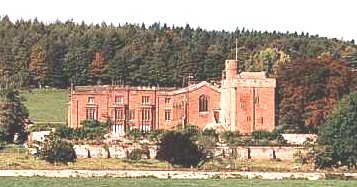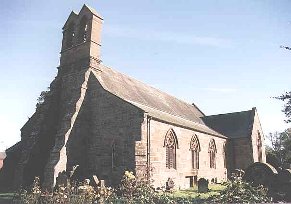Hide
Dalston, Cumberland
hide
Hide
Description from Mannix & Whellan's History, Gazetteer and Directory of Cumberland, 1847
Transcription by ?Steve Bulman? © 1999
DALSTON.

Rose Castle
Photo © Steve Bulman, used with permission.Dalston Parish is bounded on the east by Leath Ward, on the west by the parishes of Thursby and Westward, on the north by Cummersdasle, High Blackwall and Wreay townships, and on the south by the parish of Sebergham. A great part of the arable land lies rather low, inclining gently to the river Caldew, and has upon its well-wooded banks, three large cotton mills, an iron forge, a flax mill, and two corn mills. The parish is remarkable for antiquities and ancient mansions, amongst which is Rose Castle, the seat of the Bishop of Carlisle. It is divided into six townships, Buckhowbank, Cumdevock, Dalston, Hawkesdale, Ivegill, and Raughton & Gatesgill. The Grammar School at Dalston is open to all the children of the parish, at a low quarterage. In 1696, Bishop Smith endowed this school with New-hall estate in Hawkesdale, consisting of a cottage and eight acres of land, which had been forfeited by one John Lowther, who was executed for the murder of George Briscoe. The school which had been rebuilt by Bishop Smith, was taken down in 1815 and a new one erected by subscription. In 1847, the sum of 200 pounds was left to this school by Mrs Fletcher and Mrs Hodgson, executrixes of the late chancellor Fletcher, who was the last surviving trustee to the will of John Tiffin of Brownelson. He had a sum of money at his dispoal for charitable purposes. In 1841 Miss Strong bequeathed the interest of 100 pounds to be paid to a schoolmistress, for the education of poor girls in Dalston. In 1726, Dr. Benson left the interest of 50 pounds to the poor of this parish. A Mrs. Tomlinson left the interest of 100 pounds to the poor of this parish. There was an ancient hermitage near Dalston, which in 1343 was occupied by a recluse called Hugh de Lilford. Dalston Hall, now a farm house, is a very ancient building. Remains of ancient grandeur are visible on many parts of it, and at the end of a dark passage is a strong iron gate, which was intended to secure the chapel, now used as a milk house. The Dalston family, though dispossessed of the barony, retained the surrounding estate called the manor of Little Dalston, and a younger branch of them was seated at this hall till the male line became extinct by the death of Sir George Dalston, Bart. It was purchased by Monkhouse Davison, Esq. in 1761 for 5060 pounds and was sold in 1795 to John Sowerby, Esq. a native of Cummersdale, who left this neighbourhood in very humble circumstances, and went to London where he amassed wealth to the amount of 700.000 pounds. It is now the property of his son, col. Thomas Sowerby, who is lord of the manor of Little Dalston. Dalston Barony was granted by Ranulph de Meschines to Robert de Vallibus, brother of the first baron of Gilsland, who assumed the surname of Dalston. It was possessed by his descendants till King John gave Cumberland to David, king of Scotland, who settled this barony on one Morrison. But in the following reign it was seized by the English crown, with which it continued till 1230, when Henry III granted to it to Walter, Bishop of Carlisle and his successors. The barony was divided into five parts, the manor of Great Dalston and the small dependent or mense lordships of Little Dalston, Cardew, High Head and Gateskill and Raughton. Great Dalston is a mixed manor consisting of freehold, copyhold and customary tenements, with some leaseholders for life. The wife of a copyhold or customary tenant cannot be deprived of dower in this manor by the husband selling or surrendering his estate unless she join in such surrender. John Miller, F.R.S. the celebrated engine maker of the firm Miller, Ravenhill and Co. London is a native of this place.

St Michael's Church
Photo © Steve Bulman, used with permission.More photographs of the village may be found on Steve Bulman's excellent Images of Cumbria website.Dalston township has a large and populous village of its own name, pleasantly situated on the picturesque banks of the Caldew. It contains 944 inhabitants, and land is owned by several proprietors, of whom Mrs & Mr Joseph Richardson are the principal, but the Earl of Carlisle is Lord of the manor. The cotton manufacture was first introduced here by Mr George Hodson from Manchester about 1780. A market for flesh is held here every Friday. The church dedicated to St. Michael is about to undergo considerable repairs. The present incumbent is the Rev. John Wordham Dunn, B.A. Dr. Paley, Archdeacon of Carlisle, was vicar of this parish and his successor, the late Rev. Walter Fletcher, A.M. Chancellor of the diocese who died in 1846, enjoyed this living for fifty- three years, to whose memory there is a handsome marble monument with a bust, in the chancel, erected by subscription, and executed by M.A. Watson of London, a distinguished artist who is a native of this place. In 1847, George Cowen, Esq. presented to the church a handsome organ by Nicholson of Newcastle. At Ivegill is a Chapel of Ease, and in this village is a Methodist Chapel. History, Gazeteer and Directory of Cumberland. Mannix and Whelan, 1847.
[Transcribed by Carol Bennett in 1999]
More extracts from Mannix & Whelan's Directory can be found on Steve Bulman's excellent Images of Cumbria website.
